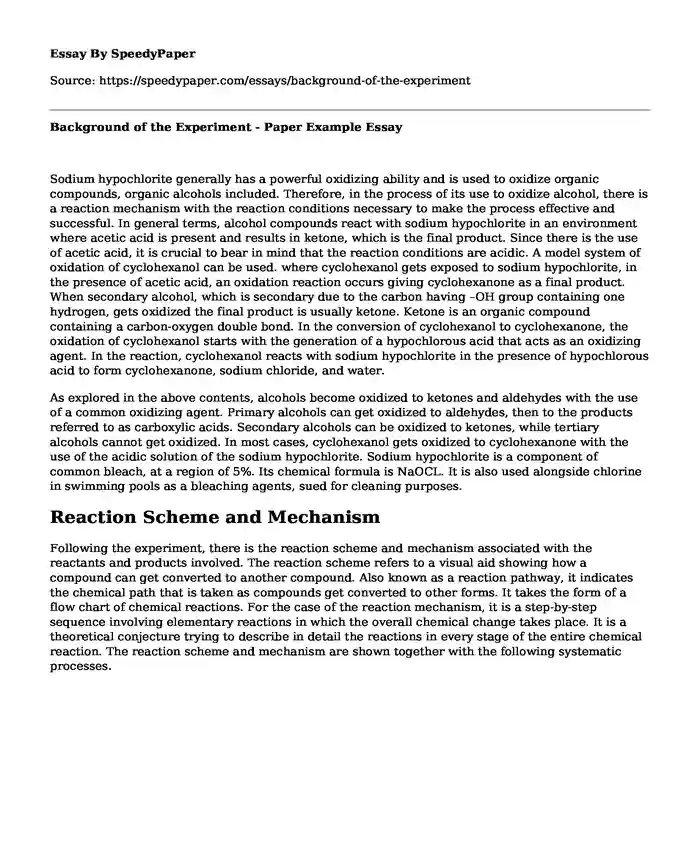
| Type of paper: | Essay |
| Categories: | Knowledge Chemistry Case study |
| Pages: | 2 |
| Wordcount: | 436 words |
Sodium hypochlorite generally has a powerful oxidizing ability and is used to oxidize organic compounds, organic alcohols included. Therefore, in the process of its use to oxidize alcohol, there is a reaction mechanism with the reaction conditions necessary to make the process effective and successful. In general terms, alcohol compounds react with sodium hypochlorite in an environment where acetic acid is present and results in ketone, which is the final product. Since there is the use of acetic acid, it is crucial to bear in mind that the reaction conditions are acidic. A model system of oxidation of cyclohexanol can be used. where cyclohexanol gets exposed to sodium hypochlorite, in the presence of acetic acid, an oxidation reaction occurs giving cyclohexanone as a final product. When secondary alcohol, which is secondary due to the carbon having –OH group containing one hydrogen, gets oxidized the final product is usually ketone. Ketone is an organic compound containing a carbon-oxygen double bond. In the conversion of cyclohexanol to cyclohexanone, the oxidation of cyclohexanol starts with the generation of a hypochlorous acid that acts as an oxidizing agent. In the reaction, cyclohexanol reacts with sodium hypochlorite in the presence of hypochlorous acid to form cyclohexanone, sodium chloride, and water.
As explored in the above contents, alcohols become oxidized to ketones and aldehydes with the use of a common oxidizing agent. Primary alcohols can get oxidized to aldehydes, then to the products referred to as carboxylic acids. Secondary alcohols can be oxidized to ketones, while tertiary alcohols cannot get oxidized. In most cases, cyclohexanol gets oxidized to cyclohexanone with the use of the acidic solution of the sodium hypochlorite. Sodium hypochlorite is a component of common bleach, at a region of 5%. Its chemical formula is NaOCL. It is also used alongside chlorine in swimming pools as a bleaching agents, sued for cleaning purposes.
Reaction Scheme and Mechanism
Following the experiment, there is the reaction scheme and mechanism associated with the reactants and products involved. The reaction scheme refers to a visual aid showing how a compound can get converted to another compound. Also known as a reaction pathway, it indicates the chemical path that is taken as compounds get converted to other forms. It takes the form of a flow chart of chemical reactions. For the case of the reaction mechanism, it is a step-by-step sequence involving elementary reactions in which the overall chemical change takes place. It is a theoretical conjecture trying to describe in detail the reactions in every stage of the entire chemical reaction. The reaction scheme and mechanism are shown together with the following systematic processes.
Cite this page
Background of the Experiment - Paper Example. (2023, Aug 23). Retrieved from https://speedypaper.net/essays/background-of-the-experiment
Request Removal
If you are the original author of this essay and no longer wish to have it published on the SpeedyPaper website, please click below to request its removal:
- Free Essay Sample: Solar PV Cleaning
- New Deal Liberalism
- Free Essay with a Critical Analysis of The Once Were Warriors Movie
- Political Parties: Party Politics at The Grassroots, Essay Example
- Essay Example: Research on Sexual Education
- Paper Example. Description of The Pathology
- Essay Sample on To Get Skills in Studying the Informational Text
Popular categories




